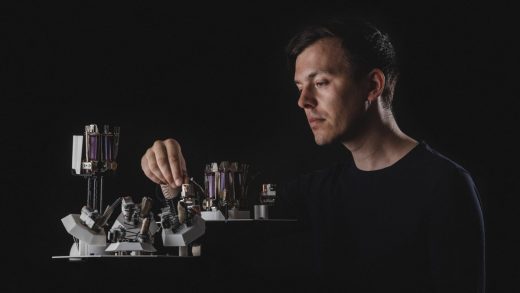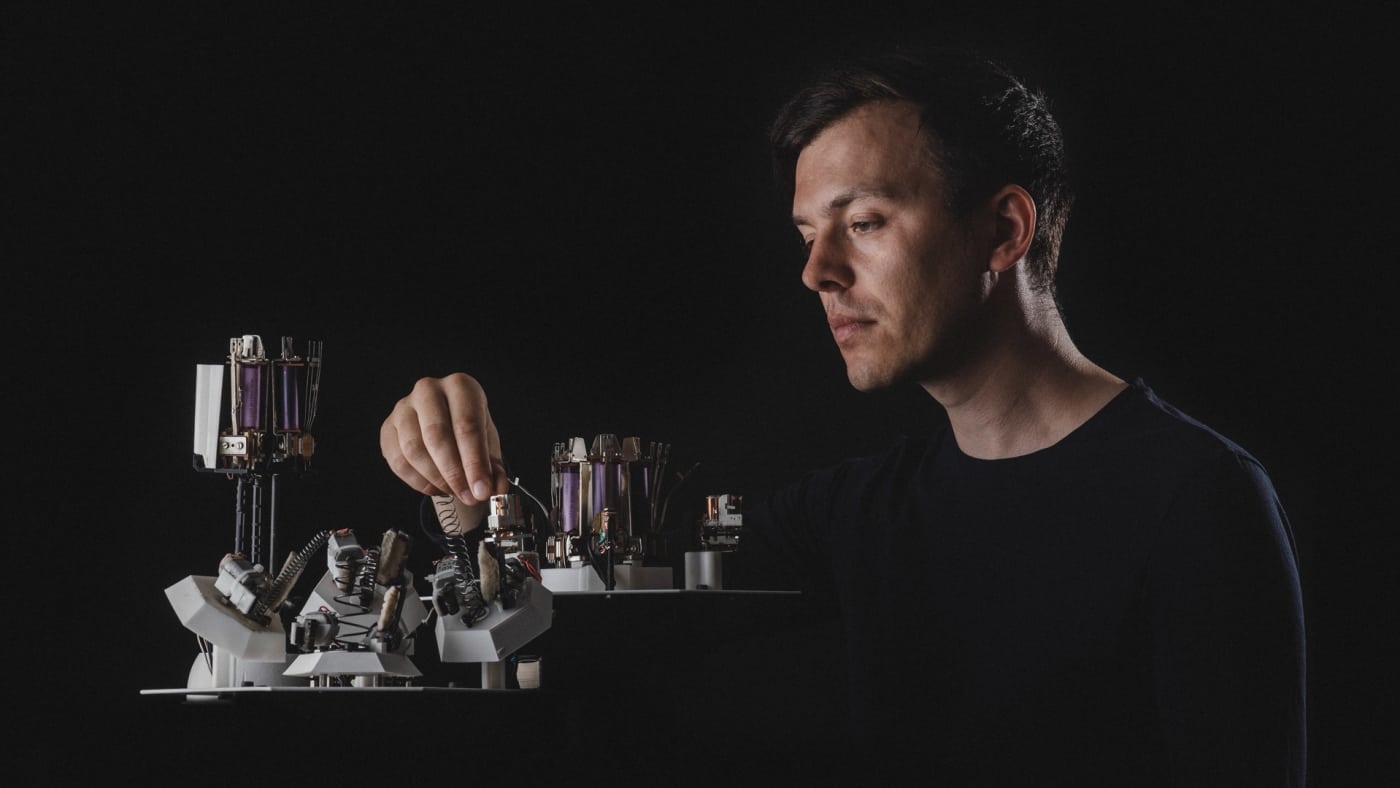To upgrade techno, this engineer plays his own robots
Moritz Simon Geist, a 30-something engineer and musician, was recently tinkering with his band. Music-making robots or “robot musicians,” if you will, might seem a gimmick, like Captured! By Robots, Japanese robot metal outfit Z-Machines, or Compressorhead, who did a cover of Motörhead’s classic track “Ace of Spades.” But Geist is deeply interested in the overall multisensory potential of robot music. For him, it’s a philosophical challenge, not simply a technological one.
“There are a lot of projects in media art that want to show how that technology exists,” Geist explains when I meet him at this year’s Moog Fest in Durham, North Carolina. “The first project that featured 3D printing was there just to show that 3D printing existed. I mean, in the beginning it’s nice, but then it kind of loses tension quite fast.”
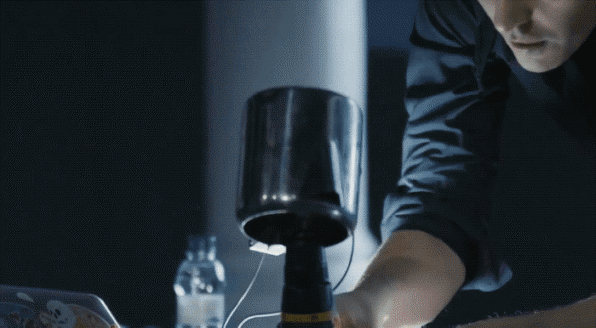
Geist sees his Tripods 1 robot system, and various other “Sonic Robots,” as he calls them, not as an end in themselves, but a means, a tool to change the way listeners engage with the music.
“Robots are kind of a futuristic way to think about music and reflect on it, but also comment on it,” he says. Geist wants his robots to sound more musical and less like mechanical gimmicks, with more natural timbres, textures, pitches, and rhythms. He’s making robot musicians, sure, but he’s also making them play make good, interesting music.
The Tripods One robots are, as the name suggests, five different robotic tone generators fixed to a central tripod, like branches to a tree. This kinetic sculpture, as Geist calls it, features various elements that mechanically pluck springs or trigger a computer hard drive’s actuator arm and head to make sounds. The robots will feature heavily on both The Mechanical Turn, due in October, and an LP, Robotic Electronic Music, set for a November release, both of which include production by Mouse on Mars, the iconic Berlin-based ambient techno duo.
Of course, these are robots, and so while there is an obvious emphasis on sound, they also look pretty cool. That’s not an accident. The robots double as art installations and live performers, and Geist builds them with that in mind. “As a human, I want to see things in multiple ways,” he adds. “I want to have a visual complement, a sound complement, and smell—I want everything. I am a multisensory being, and I want art and music to be multisensory. With robots and objects I’m getting a little closer to this idea.”
Geist was 17 years old and attending the Fusion Festival, an arts and music fest held on a former military base in Eastern Germany, when he first had the vision. “I suddenly had this idea that I had to create robots where you could walk through them and there would be sound,” Geist recalls. “When you listen to electronic music through a stereo system it’s very flat. For me, this is the future: I want to have electronic music and techno where you can walk inside it and have this LSD experience.”
The music of Autechre, the challenging Warp Records duo of Sean Booth and Rob Brown, is a good point of reference for Geist’s approach with musical automation. Since the mid-to-late 1990s, Autechre has made music (in the studio and live) using algorithms built on Max/MSP, a modular software that allows users to build their own instruments and connect them in new ways. Thus, humans influence the musical elements that the machines create and vice versa.
When he tinkers, Geist doesn’t have the luxury of software’s experimental immediacy, with its tweakable algorithms: his work is electrical and mechanical. His first big robot was a giant, interactive simulation of Roland’s iconic TR-808 drum machine. It was a minor hit, but given the 808’s exalted status in electronic music and hip-hop, it also proved too referential for Geist’s liking.
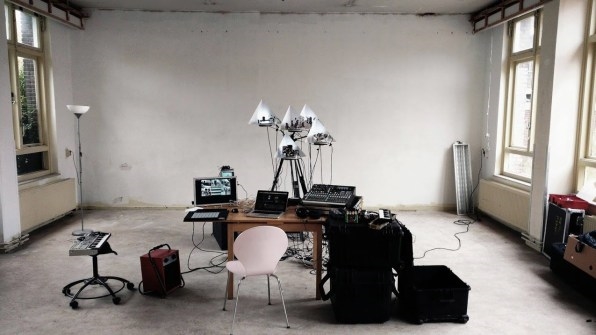
“In music robotics there are a lot of projects that take a guitar and make a robotic version of it, but this is not my thing,” Geist says. “I want to create DIY futuristic instruments which have something new to them, which don’t reference something that already exists,” and which are “very much focused on the sound.”
Geist designs his sounds to be analog and acoustic, not digital or electric. He has mined the audio possibilities of samplers and synthesizers in the past, but the artificially generated sounds don’t have the same character and unity as the robot sounds, generated “in the real world.” He isn’t afraid to get metaphysical about this.
“All my instruments are to me as one: I play them, I see them, I feel them and they talk back to me,” Geist told me. “It’s a feedback loop of form and content. I don’t want them to be mixed with something that exists already. My idea is to generate a whole new futuristic sound, and so it is conceptually, and for my own work, better to not use any synths.”
How to build a musical robot
For inspiration, Geist keeps his ears open to the sounds around him, or just tinkers in the workshop until he finds a sound he likes. “I foremost look for something which I can use musically—if I want something ‘bassdrummy,’ I come up with a metal tongue that is beaten by a motor and which almost sounds like a 808 bass drum,” he says. “Or a metal spring that is pushed and which one can easily use as a snare drum.”
He estimates that percussion robots comprise 70% of his collection of robots, mostly because they are the most stable and easiest to build. But he is also able to design robots that can replicate a synthesizer’s arpeggiated melodies, or its more atmospheric sounds.
One robot, for instance, is a mechanical relay synth with five metal tongues taken from an old Zuse relay computer, which Geist uses to produce square waves that are picked up by a guitar pickup and a microphone. Looking more like an experimental engine than musical instrument, the robot is essentially a five-voice polyphonic synth, complete with MIDI functionality and pitch bend, which Geist uses to create melodies and pads (sustained chords and notes). For melodies, Geist also uses glasses with different volumes of water to change notes, and a tuned fan to create ambient sound via the motor and airflow, amongst other things.
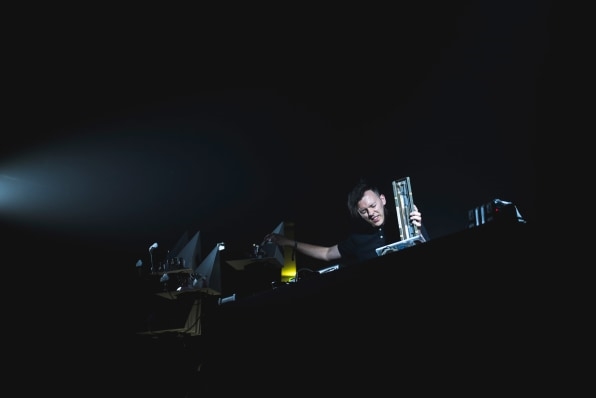
Once the robot is built, changing parameters like release (how long the note rings) or frequencies is difficult. If he uses a robotic snare drum, Geist cannot simply turn a knob to change the snare tone or release—he must actually dig into the robot and tune it by hand. Bigger changes require him to change the entire concept.
“With music robots you have a lot of constraints,” says Geist, “but that’s what actually thrills me. With synthesized music creation I am often overwhelmed with endless possibilities, and for the [songwriting/sound design] process as well as for the final [track] that is not interesting for me anymore.”
Geist has been busy in his Dresden robotics workshop, which doubles as his recording studio, playing and adjusting and playing Tripods 1. The robotic instrument/installation can do chromatic scales (the 12 most common pitches in Western music) and create sounds that vary from metallic crashes to roboticized bells, and many things in between. For the robotic techno EP and LP, Geist is layering the robotic instruments track by track. Similar to how traditional bands record, Geist tracks the drums in their entirety first, then adds the other instruments’ sounds sequentially.
“I didn’t have the studio space and recording techniques to do it live,” says Geist. “I was doing the recording in my workshop mostly, and the mixing and production at Mouse On Mars’ studio [in Berlin]. I also didn’t have the time, and there were problems with volume.”
The mouse on mars spaceship is ready to take off #sonicrobots
@MoM_official
pic.twitter.com/7PzOqtisfj—
M??I?Z ?IM?? GSI?? (@simongeist) August
24, 2018
Geist and Mouse on Mars did some editing with software, but when Geist felt it was too much, he’d return to his studio, tweak the robots’ sound, and re-record. It was a learning process, given that up to that point Geist had only performed with his robots live.
“What we did, for example, is use distortion or other stuff like equalization and compression, and through that, the sound of the robots changes,” he says. “This made me think about my own robotic sounds differently, and other times it changed the character of the track so severely that I had to rearrange. I did this mostly in Mouse On Mars’ studio, but then went back to my workshop and re-recorded in a different way.” The back and forth between Geist’s workshop and Mouse on Mars’ studio would result in a two-year recording journey.
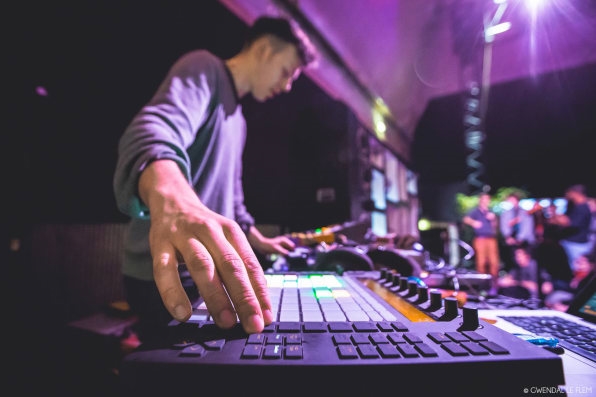
The goal is to record the next album live, all at once. “In one or two years it will probably be possible to record all at once when I have a better studio.” For the upcoming album, he is producing videos of the Tripod 1 performing album material live. “I’m a bit dogmatic—there shouldn’t be too much editing,” Geist insists. “The idea is that you can really use this in the real world and not have too much influence from digital processing… I think it has a very organic sound.”
In the future, Geist wants his Sonic Robots to perform live in seamless fashion too. Ideally, the sound will be as harmonious as a real band or orchestra. But there will be one big difference between his robot musicians and human performers: the performance space.
“Imagine a room, not a stage, where all the robots are placed and people can walk in between the robots and there is immersive 3D sound,” he muses. “I want them to sound naturally so good that it is a really good experience.”
Kraftwerk, the pioneering electronic outfit, made what they called “robot pop.” They even used crude robotic simulacra of themselves to reinforce the idea that the sound and spectacle was, after all, mechanical, even if humans triggered the electronic instruments. Geist’s robots aren’t meant to simulate humans or a band, but to fulfill specific, finely tuned tasks, like industrial machines. These are new machines, manufacturing a new kind of machine music.
His little robots help provide an important corrective too, he says. They inject a new, multi-sensory dimension to the processes of making of and listening to electronic music. Since ancient times, music always had a visual accompaniment. If someone played a violin live, the audience saw the violin and the player. Whether a violin or an analogue synthesizer, music emanates from one object. Geist considers this a “natural experience.”
“But then you have the computer, and the body of the music is really gone,” Geist argues. “The computer is a multipurpose tool for doing a lot of stuff, but there isn’t really a body. So, I was thinking that I really have to give the body back to electronic music because this creation process with only a computer and no body is not natural.”
Fast Company , Read Full Story
(25)

